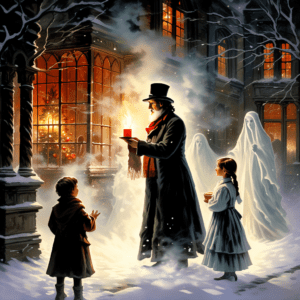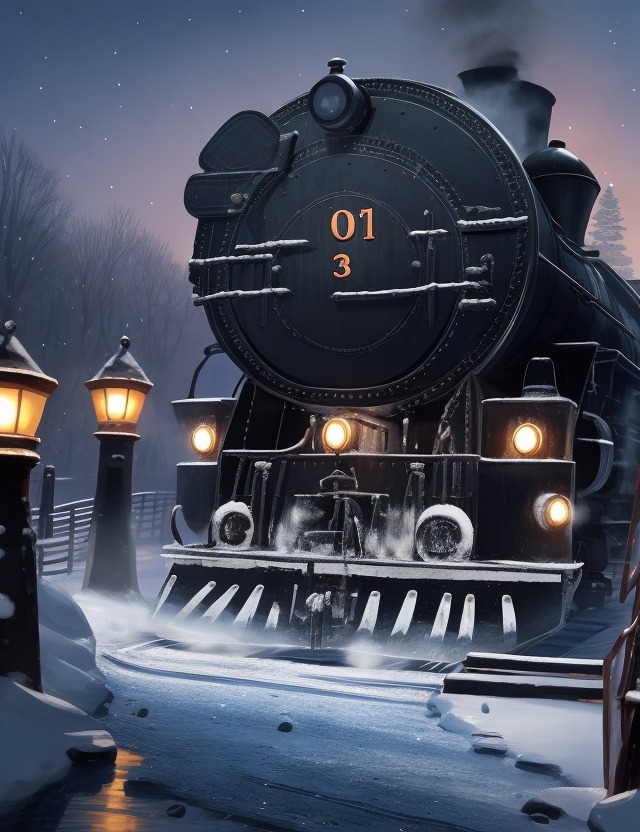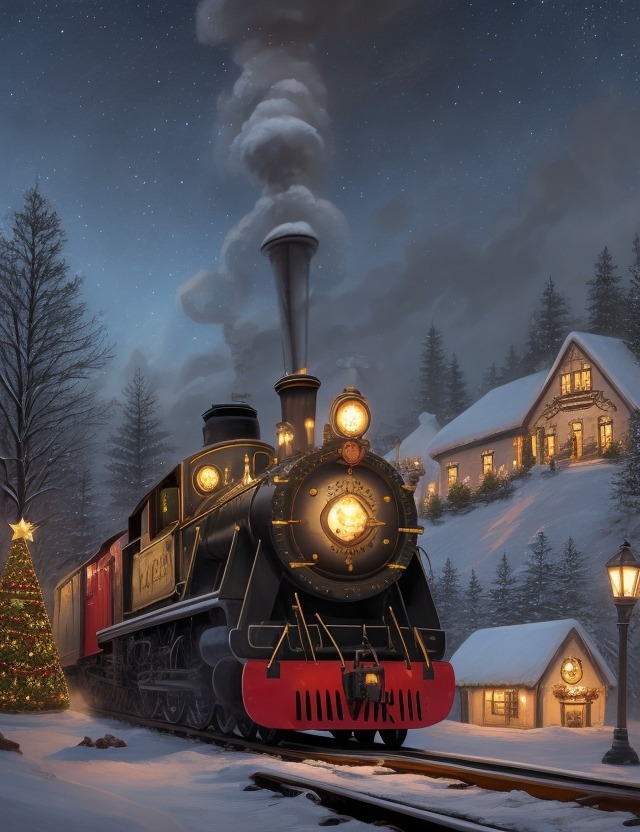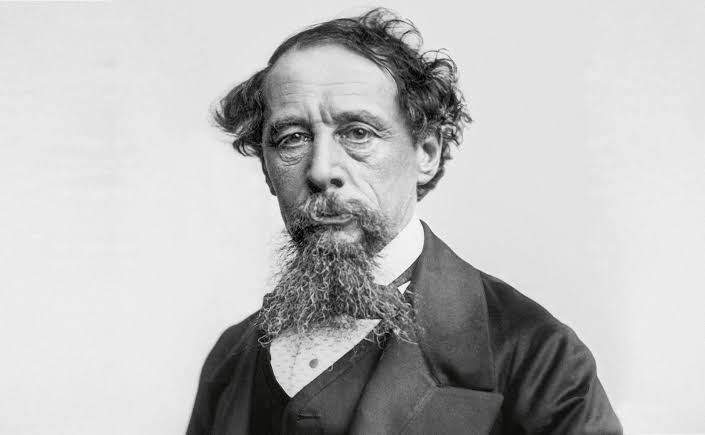Christmas stories for kids are a popular genre of short stories for kids because they evoke the magic and joy of the holiday season. These stories are filled with cheerful characters, festive settings, and heartwarming messages, helping to create a sense of wonder and excitement in young readers with a narrative Christmas story.
The appeal of Christmas stories lies in their ability to tap into children’s imagination, curiosity, and emotions. Through vivid descriptions and engaging narratives, these stories transport children to a world of holiday festivities, filled with snow-covered landscapes, jolly Santa Claus, and talking animals. This genre fuels kindergarden children imagination by presenting whimsical scenarios and magical elements that captivate their young minds.
Furthermore, Christmas stories for Children often include elements of mystery, adventure, and self-discovery, which appeal to children’s curiosity. Whether it’s a lost present, a journey to the North Pole, or a quest to save Christmas, these stories encourage children to explore and ask questions, stimulating their natural inquisitiveness.
Emotionally, Christmas stories connect with children on a deep level. They showcase themes of love, friendship, generosity, and the importance of family bonding. By portraying relatable characters and their heartfelt experiences, these stories elicit emotions such as joy, empathy, and excitement in youth readers. The sense of wonder and happiness that permeate these stories resonates with the inherent innocence and enthusiasm of children, making this genre particularly appealing during the holiday season.
Best Christmas stories to read
Looking for the Best Christmas Novels?
Christmas Short Stories Genre: Examples
Some of the best and most representative examples of the genre of Christmas are:
1. A Christmas Carol by Charles Dickens:
“A Christmas Carol” is a timeless classic that tells the story of Ebenezer Scrooge, a bitter and miserly old man who is visited by three spirits on Christmas Eve. Through these encounters, he is forced to confront his own shortcomings and transform into a generous and compassionate person. This novella not only captures the spirit of Christmas but also explores themes of redemption, empathy, and the importance of human connection.
Why I chose this work: “A Christmas Carol” is a seminal piece of literature that has been adapted numerous times across various mediums. It reflects the appeal of the Christmas genre through its heartwarming theme, short Christmas story with a moral lessons, and the transformation of a seemingly irredeemable character.
2. Home Alone directed by Chris Columbus:
“Home Alone” is a beloved Christmas comedy film that follows the misadventures of young Kevin McCallister, who gets accidentally left behind by his family during the holiday season. Kevin must defend his home against two bumbling burglars using a variety of hilarious and inventive traps. This film embodies the spirit of Christmas through themes of family, love, and the importance of togetherness.
Why I chose this work: “Home Alone” is chosen as an example of the Christmas genre because it showcases the diversity within the genre. While it is a comedy film, it still captures the essence of the holiday season and appeals to audiences of all ages.
3. “The Night Before Christmas” by Clement Clarke Moore:
“The Night Before Christmas” is a popular poem that narrates the story of a visit from Santa Claus on Christmas Eve. It beautifully captures the anticipation and excitement felt by children as they wait for Santa’s arrival, describing his appearance, his reindeer, and his process of delivering gifts. This poem has become a staple during the festive season, often read or recited by families as a tradition.
Overall, these examples showcase the genre of Christmas through various mediums, including literature, film, and poetry. They demonstrate the genre’s enduring appeal by highlighting the universal themes of love, family, kindness, and the spirit of giving that are central to Christmas. Additionally, these works reflect the diverse ways in which the genre can be experienced, enjoyed, and celebrated, making Christmas a relevant and beloved genre for many people around the world.
Christmas Short Stories Genre: Authors
Some of the famous authors of Christmas literature are:
1. Charles Dickens:
Charles Dickens is widely regarded as one of the most prominent authors in Christmas literature and is known for his novel “A Christmas Carol.” Published in 1843, this book is a timeless classic that tells the story of Ebenezer Scrooge’s transformation from a miserly old man to a compassionate individual after being visited by three ghosts on Christmas Eve. Dickens’ portrayal of the Christmas spirit and themes of redemption and charity greatly influenced the way Christmas is celebrated and perceived in Western culture.
2. Dr. Seuss:
While Dr. Seuss is known for his whimsical children’s books, he also made a significant contribution to the Christmas genre with his book “How the Grinch Stole Christmas!” Published in 1957, this story follows the Grinch, a bitter and grumpy creature, as he attempts to steal Christmas from the joyous Whos of Whoville. Dr. Seuss’ imaginative storytelling and the book’s underlying message about the true meaning of Christmas have made it a beloved holiday classic.
3. Hans Christian Andersen:
Although primarily recognized as a writer of fairy tales, Hans Christian Andersen wrote several Christmas-themed stories that have become popular classics. One of his notable works is “The Little Match Girl,” published in 1845. This poignant tale tells the story of a poor young girl who sells matches on the streets and has a series of vivid visions on a chilly New Year’s Eve. Andersen’s stories often combine a sweet sentimentality with a touch of melancholy, evoking emotions and adding depth to the Christmas literature genre.
4. Clement Clarke Moore:
While not a prolific writer, Clement Clarke Moore is renowned for his poem “A Visit from St. Nicholas,” commonly known as “The Night Before Christmas.” First published in 1823, this iconic poem popularized beloved Christmas traditions such as Santa Claus, his reindeer, and the concept of him descending chimneys to deliver gifts on Christmas Eve. Moore’s vivid descriptions and the whimsical nature of his poem greatly influenced subsequent portrayals of Santa Claus and the overall imagery associated with Christmas celebrations.
These authors contributed to the development and popularity of the Christmas genre by creating enduring stories that capture the magic, spirit, and themes of the holiday season. Their works have been adapted into numerous films, plays, and adaptations, ensuring their continued influence on readers and audiences around the world. These authors shaped the perception of Christmas, emphasizing the importance of love, generosity, and the joy of giving during the festive season. Their storytelling prowess and imaginative narratives have made their works synonymous with Christmas time, etching them into the cultural fabric of Christmas celebrations.
Christmas Short Stories Genre : History
The genre of Christmas music emerged in various cultural and historical contexts, influenced by different social factors. Its origins can be traced back to ancient pagan celebrations of winter solstice, where people celebrated the return of longer daylight hours and the promise of spring. These festivities often included music and dancing.
However, the genre took a significant turn with the emergence of Christianity. The celebration of Christmas as the birth of Jesus Christ became an important event in the Christian calendar. Christmas story of the bible. As Christianity spread across different regions, local customs mixed with religious beliefs, influencing the development of unique Christmas music traditions.
Pioneers of Christmas Short Stories
One of the pioneers of Christmas music is Saint Francis of Assisi, who is said to have created the first nativity scene in Greccio, Italy in 1223. Saint Francis also wrote a song called “Canticle of the Sun,” which is considered one of the earliest Christmas carols.
Another influential figure in popularizing Christmas music was Martin Luther. In the 16th century, he composed numerous hymns, including the famous “Away in a Manger” and initiated the tradition of singing carols in German in churches during the holiday season.
During the Victorian era in the 19th century, Christmas music gained wider popularity. The influence of the industrial revolution and increasing urbanization led to new trends such as the commercialization of Christmas. Charles Dickens’ novel “A Christmas Carol” played a significant role in reshaping the holiday and emphasizing themes of charity, compassion, and family.
In the United States, the late 19th and early 20th century witnessed the rise of Christmas music as a commercially successful genre. Popular composers like Irving Berlin, who wrote “White Christmas,” and Johnny Marks, who wrote “Rudolph the Red-Nosed Reindeer,” contributed to the development of iconic Christmas songs.
In recent decades, various trends have emerged within the Christmas music genre. These range from traditional renditions of carols to modern reinterpretations and original compositions. Artists such as Mariah Carey, Bing Crosby, and Nat King Cole have produced some of the landmark works that continue to be associated with Christmas music.
Overall, the genre of Christmas music has evolved through a complex interplay of historical, cultural, and social factors, influenced by both religious and secular traditions. It continues to be a crucial part of holiday celebrations worldwide, bringing joy and festivity to people of different cultures and backgrounds.
Christmas Short Stories Genre: Characteristics
The genre of Christmas literature comprises works that revolve around the holiday season, particularly Christmas celebrations.
Key characteristics
This genre include themes of love, joy, togetherness, and giving, as well as a focus on the traditions and values associated with Christmas.
Language in Christmas literature
Often employs a sentimental and festive tone, with an emphasis on creating a warm and cozy atmosphere. Descriptive language may be used to evoke a sense of wonder and magic. Additionally, phrases and vocabulary related to Christmas traditions and symbols, such as Santa Claus, Christmas trees, and carols, are frequently employed.
Plot in Christmas literature
Commonly revolves around the anticipation and preparation for Christmas, often culminating in a heartwarming resolution or happy ending. Characters may include Santa Claus, elves, reindeer, and ordinary individuals experiencing the spirit of the season. The setting typically includes a wintry landscape, often depicted with snow-covered scenes and cozy houses adorned with Christmas decorations.
The tone of Christmas literature
Generally uplifting and hopeful, aiming to evoke positive emotions and a sense of holiday spirit. It aims to create a sense of joy and wonder, promoting the values of love, kindness, and goodwill towards others.
Some typical themes and topics explored in Christmas literature include family, friendship, generosity, the importance of giving, and the power of belief.
Messages often emphasize the importance of cherishing loved ones, spreading joy, and finding happiness in the little things. Christmas literature also often portrays the transformational power of Christmas, where characters experience personal growth and discover the true meaning of the holiday season.
Christmas literature is directly related to the interests and needs of children as it captures the sense of magic and wonder that is often associated with the holiday season. It provides an opportunity for children to engage in stories that reinforce positive values and embrace the joy of Christmas. It can also help children understand the importance of kindness, gratitude, and empathy towards others, fostering a sense of community and togetherness.
Christmas Short Stories Genre: Benefits
Reading Christmas books can provide numerous benefits for toddlers.
Firstly, it enhances reading comprehension by exposing children to different narrative structures, character development, and descriptive writing styles.
This genre often incorporates elements of adventure, friendship, and family, which engage Christmas Story lessons for youth readers and encourage them to comprehend and interpret the storylines. Through reading Christmas books, kids can develop their ability to understand and absorb text.
Moreover, this genre facilitates the expansion of vocabulary.
Christmas-themed books often introduce unique holiday-related terms, festive language, and descriptions of traditions or celebrations. Exposing kids to these new words can enhance their linguistic abilities and enrich their vocabulary, allowing them to express themselves more effectively in writing and verbal communication.
Christmas books can also foster critical thinking skills. Many stories in this genre feature moral dilemmas, problem-solving situations, or decision-making processes that encourage children to think critically and analyze the consequences of characters’ actions. By engaging in these thought processes, kids can enhance their analytical abilities and develop their own problem-solving strategies.
Reading Christmas books broadens kids’ horizons by introducing them to diverse cultures and traditions.
Since Christmas is celebrated in various ways around the world, these books can provide insights into different customs, beliefs, and practices. This exposure can help children appreciate cultural diversity, understand the importance of inclusion, and develop empathy towards people with different backgrounds.
Additionally, Christmas books enrich kids’ cultural knowledge by showcasing various historical, religious, and social aspects related to the holiday. Learning about the origins of Christmas or the historical figures associated with it can deepen their awareness of these subjects.
In terms of fostering creativity, Christmas books often include imaginative settings, festive themes, and unique characters.
Engaging with these stories can inspire children’s own creativity, encouraging them to think outside the box, create their own narratives, or even develop new holiday traditions. Christmas books can serve as a catalyst for imaginative play and artistic expression, empowering kids to think creatively.
Lastly, reading Christmas books can motivate and empower children to pursue their goals and dreams. Many stories in this genre revolve around themes of hope, kindness, generosity, and achieving dreams. By reading about characters who overcome obstacles, set goals, and work hard to achieve them, children can feel motivated to pursue their own aspirations. The positive and uplifting messages in Christmas books can instill a sense of empowerment and encourage kids to believe in themselves and their dreams.
Christmas Novels Genre: Tips
Reading:
1. Explore a variety of Christmas literature, including traditional stories, picture books, poems, and novels. Familiarize yourself with the different themes, styles, and interpretations within the genre.
2. Create a Christmas reading list that includes classics as well as contemporary works. Encourage students to choose books that align with their interests and reading level.
3. Set reading goals or challenges related to Christmas literature. This could involve reading a certain number of books, completing a book review, or discussing favorite Christmas stories in small groups.
4. Facilitate discussions about the symbolism, themes, and messages present in Christmas literature. Encourage critical thinking and analysis skills to deepen comprehension.
5. Encourage students to make connections between their own experiences and the stories they read, fostering empathy and understanding.
Writing:
1. Prompt students to write their own Christmas stories, poems, or letters. Encourage creativity and individual expression.
2. Provide writing exercises focused on descriptive language, vivid imagery, and the use of sensory details, highlighting the festive atmosphere of Christmas.
3. Develop writing prompts that explore different perspectives, such as writing from the point of view of a holiday ornament or a character from a favorite Christmas story.
4. Encourage students to revise and edit their work, emphasizing the importance of clarity, organization, and coherence in their writing.
5. Create opportunities for students to share their writing with one another, fostering a supportive and collaborative writing community.
Teaching:
1. Create a festive classroom environment by incorporating Christmas decorations, themed books, and holiday-related activities.
2. Use multimedia resources, such as videos or songs, to engage students in discussions and activities related to Christmas.
3. Develop cross-curricular connections by exploring the historical, cultural, and social aspects of Christmas through various subjects, such as history, art, music, or geography.
4. Incorporate hands-on activities, like Christmas crafts or cooking projects, to provide a multisensory experience and make the learning more engaging.
5. Adapt and differentiate teaching strategies to meet the needs and interests of diverse learners. Provide choice and flexibility in assignments to encourage student engagement and motivation.
6. Create opportunities for students to share their own Christmas traditions or experiences, fostering a sense of inclusivity and cultural awareness in the classroom.
Improving Skills:
1. Read extensively within the genre to expand your knowledge and familiarity with Christmas literature.
2. Join or form a book club or reading group focused on Christmas literature to engage in discussions and gain insights from others.
3. Attend workshops, conferences, or online courses to learn about best practices in teaching Christmas literature and writing.
4. Seek feedback from colleagues or mentors on your teaching techniques and reflect on ways to improve.
5. Engage in professional development opportunities to enhance your understanding of the genre and stay updated on new releases and trends within Christmas literature.
Overall, by immersing yourself in the genre of Christmas literature, continuously seeking to improve your skills, and being creative in your teaching approaches, you can effectively engage, challenge, and support students in exploring the joy and magic of Christmas in their reading, writing, and learning experiences.
Where can I find the Christmas story in the Bible?
The Christmas story can be found in the Bible in Luke 2:1-20 and Matthew 1:18-2:12 . The story of Jesus’ birth is also mentioned in the Old Testament, specifically in Isaiah 9:6 .
In Luke 2:1-20, the story of Jesus’ birth is told, including the journey of Mary and Joseph to Bethlehem, the birth of Jesus in a manger, and the visit of the shepherds to the newborn child.
In Matthew 1:18-2:12, the story of the wise men who followed the star to Bethlehem to find the baby Jesus is told .





